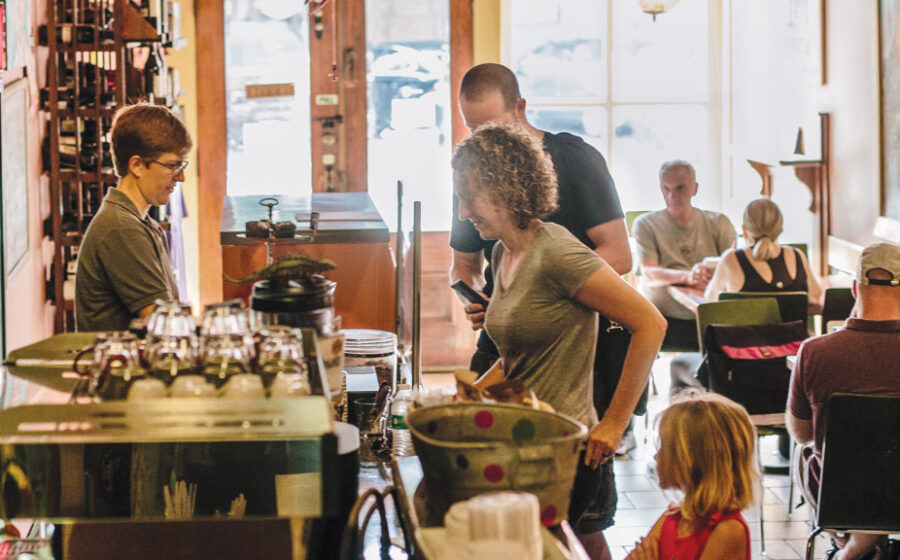[L]isten closely and respond thoughtfully. That’s an anchor principle of good hospitality, and when we decided to undertake a coffee transformation, as I detailed in the past two installments of this study, that truth became increasingly important. Not everyone loves change, but I do. Summit Coffee does. As a result, navigating that tension brings forefront the narrow difference between exciting and angering customers.
Trust is paramount in coffee shop culture. I, the coffee shop owner, trust that we sell a desirable product. I trust that we create a culture that makes you feel safe, makes you want to hang out, and then makes you want to hang out again. In turn, you, the customer, trust that you’re buying a well-made product. You trust that you are getting value for your money, that the experience you get once you walk in our doors is worth the time you’re giving it.
Trust is powerful. We’ve been open since 1998 because of earned trust. Our new customers become returning customers, then help make new customers by sharing their experience. Paraphrasing restaurateur Danny Meyer’s idea, success requires near-perfect customer service (the exchange of goods) and hospitality (the environment in which those goods are exchanged), which lead to raves (shared positive experiences).
Yet while trust is one of the hardest things to earn, it’s one of the easiest to lose. In our thirty-month transformation, we’ve lost customers. And each one of them hurt. Beth, who wanted her milk steamed to 180 degrees, stopped coming after being a regular for sixteen years. Lisa, who liked her cappuccino made with three Equals, decided that not having six different sugar packet options was the last straw. In those relationships, and in a few others, we either failed to listen closely or respond thoughtfully.
Trust is powerful. We’ve been open since 1998 because of earned trust.
People who don’t like change can get on board, I’ve discovered, if they understand the “why.” If you make alterations to drinks or to the menu that folks don’t understand, and you don’t do anything to help them get there, you’ve lost the trust. A regular customer of ours, Brad, loved bigger-than-big dark roasts that were pretty over-extracted. When we refined our brewing and roasted things a bit lighter, he felt lost looking at our offerings. So Evan, our roaster, and I brought him in for a cupping and spent ninety minutes walking him through the catalog. Now Brad almost always gets a single-origin coffee—sometimes a V60!—and understands our coffees so much better.
Still, for the 500-something customers who return to see us more than once a week (and, often, more than once a day), we kept the trust. We’re slowly coming out the other side of an “is this really a good idea” project to turn a good coffee shop into a great coffee business. Here’s how:
Vision. Know what you’re doing. Don’t change just for the sake of it. We knew our coffee program had gotten stuck in neutral sometime between 2008 and 2011, and that we hadn’t realized it until 2014. And we knew that being good wasn’t enough for us. I want to be excited when a coffee professional comes in and orders a cortado, not terrified.
Conviction. Know why you’re doing something. If you make it a point to change, go all in and own that. Customers want to trust that we know what we’re doing, how we’re doing it, and, ultimately, why. Know who you are, and be proud of that. If the vision is right and business plan is sound, it will work. But the second you start doubting yourself, you’re showing you distrust your own ideas.
Patience. As I spelled out in Part II of this study, retraining a staff of thirty-six takes so much time. Convincing a slightly-behind-the-times town of 12,000 that change is not only necessary, but in fact good, takes so much effort. One step at a time, one barista at a time, one customer at a time. “What’s different with your coffee?” a loyal-to-the-core eighty-two-year-old customer asked me this week. “I always enjoyed it, but now it’s really good.” Four days later, I still grin about that brief exchange. How cool is that?
Awareness. No customer is more important than any other. I want that coffee professional to get an awesome cortado, for sure, and I want him to remark on that to other people that care about coffee. But, just as much, I want the twenty-ounce, extra-hot cappuccino customer to find a new drink and be excited about it. Listen carefully and respond thoughtfully. Sit down and share a coffee and conversation with those customers. The ones who want to ask questions or want to volunteer concerns are not, in fact, annoying. They are the customers who care. Treat them as such.
Pride. Have ownership and confidence in all that you do. This business—be it a coffee shop, a coffee roaster, a clothing boutique, whatever—is running on my vision. If I can’t take pride in what it represents, in what it serves, in what it looks and feels like, how can I ask the same from my staff? Take a moment to be proud of what you’ve accomplished, in what you’ve built, and of the community that exists within all of that.
Now it’s time to get back to work.
—Brian Helfrich is the co-owner of Summit Coffee Co. in Davidson, North Carolina.
















